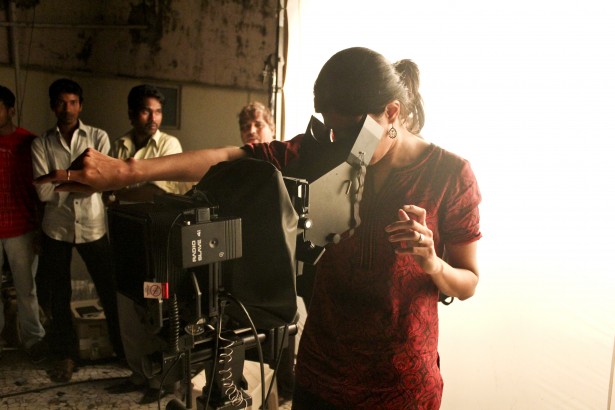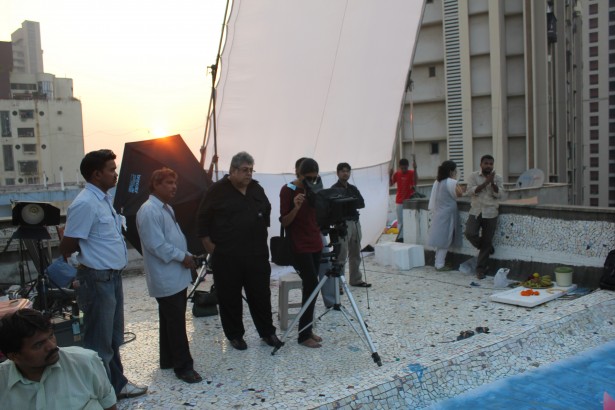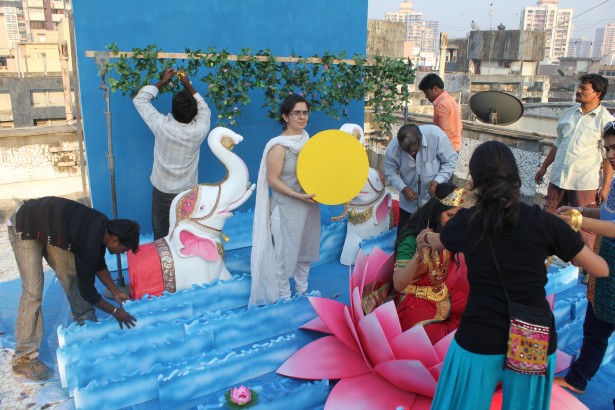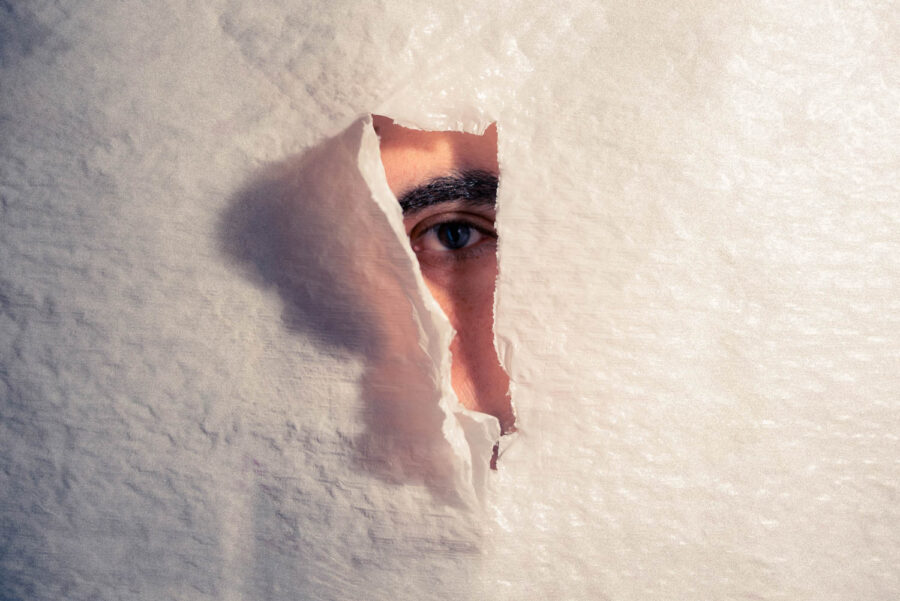In the last few years Manjari Sharma has taken the photo world by storm. You could blame her charm and that constant smile on her face, but really, it is her photographs that set her apart. Sharma has developed a sophisticated eye and a body of work that speaks for itself, now we are thrilled to support her as she embarks on a new photographic journey. We have seen Manjari grow as an artist over the years and have shown her work in Across The Divide: Critical Mass 2010 and our 2010 Photolust annual auction, where her work was a big hit! Manjari has graciously agreed to answer some questions for us, so here we go…

1. Your most successful and prolific body of work so far has been your shower portraits. This new project, Darshan, is very different. I’m curious about your subject transition, from photographing nude subjects in the shower to creating classical images of Hindu gods and goddesses. As one of the subjects in your shower series myself, we engaged in a conversation about the sexual/intimate nature of the experience and the implications your cultural upbringing brought along. Can you elaborate on your subject transition? How do you balance the act of literally showering with you subject as opposed to making images of your sacred gods? Do they inform one another in any way?
Great question Rafael. in fact in a recent conversation with a subject for the Shower Series, we discussed how spirituality and sexuality are both sides of the same coin. People want to be sexual and they want to be spiritual and the process of understanding both takes time! What I learned in the shower was about the power…
human connection and how our fragility is one of the most beautiful things that connects us as people. Nudity was a part of the process in the shower series, but not the spotlight. Yet the sexual nature of the subject matter could not be ignored. My project Darshan aims to photographically recreate 9 classical images of gods and goddesses pivotal to mythological stories in Hinduism. For me Darshan is the culmination of photography and spirituality, both topics have been objects of my devotion life long. Looking at a series comprising of classical images of HIndu deities may make people wonder if it’s a project touting religion, and while that cannot be ignored, it’s again not the spotlight. This project is about a sense of human connection. My subjects in the images appear to be gods and goddesses, bearing strong resemblance to the iconography of Indian culture we are used to seeing. Yet they are real people like you and me. Unreal moments can be fashioned out of concrete reality and that is one of my favorite challenges and wonder of using photography.
In a sense, a place like the shower, a place of everyday practical use could transport us into a spiritual experience. Similarly in Darshan we learn that a seemingly extraordinary and unreal sight that feels other worldly is a constructed set fashioned of very concrete elements. In India we say “Namaste” as a common greeting to each other and it comprises of holding your hands together at your chest and bowing down in respect; It’s especially done when you stand before a deity in a temple. Namaste quite literally means, the spirit in me respects the spirit in you. If we feel a sense of bowing down to a God or Goddess in an image from the Darshan series, we are ultimately bowing respect to the spirit of another human being looking back at us, which gives takes Namaste to a whole different level for me. In all my series, be it the Shower, Darshan or even Anastasia context is a common string.

2. Darshan is a real production, a huge endeavor. Tell us more about your workflow and process as you create these images.
I take the time to plan my lines, my colors, perspective and proportions and aim to create the image with as much explicit detail as possible. It is my aim to create from scratch everything required to make the images in this series. In order to create the image of Maa Laxmi for example, the research came first. All aspects had to be studied – from wardrobe to significance. With measuring tapes all over the set, we studied and tried to understand vanishing points which can be fluidly controlled in painting but needs to planned carefully alongside symmetry in the photo. Let’s not forget we were shooting film, 4×5 to be specific! In order to create the final results, A diverse crew of 14 people came together: it included set & prop builders, makeup artists, art directors, painters, carpenters, jewelry experts and assistants. All of these people that you can see on the video were handpicked from their respective areas of expertise. The model you are looking at was also very carefully chosen after many auditions. Maa Laxmi’s expression in the photograph is one that had to be very intently studied in order to emulate. The whole production was time intensive and required meticulous attention because for me the sense of spirituality was heavily contingent on the authenticity and detail in the image. Watching the video would be really the best way to get a sense of the project so I urge people to check it out here.
3. Where will you be working when you produce this work? How important is it for you to involve members of your own culture/community in creating the imagery?
The project is being photographed in Mumbai, India where I was born and raised. This project needs to be shot in India for many reasons, but one of the main ones is that everyone in the crew is from the culture. All team members are very familiar with the subject matter and have a great deal of respect for what they are working on. Many turned out to be ardent devotees of one God or another. The girl who played the character of Maa Laxmi is herself a big devotee of Maa Laxmi. All of the energy of the crew combined with the fact that I am in the birthplace of the tradition does make a huge difference to the project.

My family is very spiritual and my parents exposed me to Hinduism, its teaching and artifacts from a very early age. Visiting countless Indian temples frequently was common practice to us. So at a more personal level, my parent’s involvement has also greatly influenced the project. Having perspective that if you have faith, you will receive the grace you need to complete something of this stature is a really important mantra to remember when you take on a subject of this magnitude. My parents do a fantastic job of reminding me of the humility a project like this needs.

4. What is your vision for this project?
Darshan is a Sanskrit word that means ‘sight,’ ‘view’ or ‘vision’. I want the final show to be a “Darshan” of this series to the world at large.
I see the whole project displayed as an installation of 6 feet tall prints. Once complete, I see the exhibit designed to evoke the experience of a Hindu temple in Museum. Just as in a temple, the images will be lit up and cordoned off from the viewer. The route to their Darshan will be delineated such, that the seeker will be guided from image to image taking in a unified experience which will aim to be memorable by engaging all senses. Audience wise, I want people who are appreciators of both art and/or religion; Curious souls and seekers who are intrigued but have have maybe never experienced the culture first hand to see the show. I want people who may otherwise not enter a Hindu temple to maybe go into a museum and get to study these images and the experience from just an artistic and or a cultural standpoint; But without the baggage that a house of worship or religion comes with. Similarly I want maybe a spiritual or religious HIndu to be able to experience the deities outside of a Hindu temple and be able to re-live the same experience out of context. At a larger level, Darshan has now became a cultural calling for me to preserve my heritage by using the medium of photography.

5. How can we help?
I funded the creation of Maa Laxmi the first deity myself but to fund 4 more images in Darshan I created a three minute video which can be found at this link.
The video showcases the behind the scenes/ making of the first image. Using the tools of traditional video, photography, illustration and simple animation the video walks you through what this task entailed. I hosted this video on a site called Kickstarter. Kickstarter is a collaborate funding website. If you as a viewer enjoy the project, you have the choice to pledge financial support to the project in exchange for worthy rewards. Since I am driven to make this extremely expensive project come to life I am offering limited edition prints and other rewards in exchange for your financial backing. The Kickstarter deadline to raise as much as I could to support this project is August 28th. If you watch the video and feel connected, I urge you to be agents of art and contribute to Drashan for a unique print from the series. The more I raise the more images I’ll be able to create, so If you feel compelled, don’t hold back there’s only four days left to be backer for this project. If you have a second, you can share the project with a friend and I thank you for your time!



